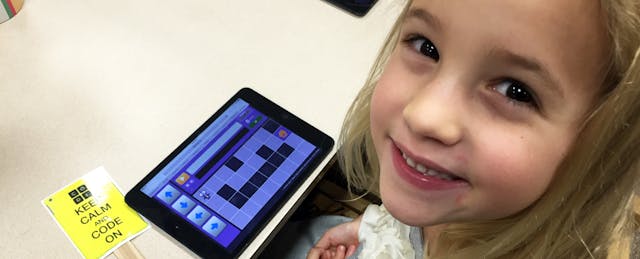My five-year-old girl entered kindergarten this past fall, bringing me one of life’s greatest experiences: watching her explore her curiosities and creativity as she desires and develops skills that will last her a lifetime. Her energy and joy for learning is inspiring. Each morning before school, she’ll sprint up the bus steps, only stopping to give a quick wave back home. She’s anxious to get to school and enters each day with a natural curiosity and desire to learn. From designing worlds in Minecraft, to using such learning tools as Dash and Dot, Osmo, Code.org, and Ozobot, her passion for science, math and technology radiates.
Recently, after completing her math homework, she looked up at me and said, “Daddy, I just love math. I’m so good at it.” I savored the moment because like any parent, I don’t want my daughter to end up being a negative statistic.
Quite often, our K-12 system ends up schooling the love of learning out of students by the time they graduate. Will my daughter have the same desires in high school? Will she yearn to learn with the same level of excitement as she gets older? Will she remain confident and continue to love her current passions of math, science and technology?
Statistics suggest not. During her keynote presentation at FETC, Reshma Saujani, CEO of Girls Who Code, shared this glum observation: In 1984, 37 percent of all computer science graduates were female; now that number has been cut in half to only 18 percent. Moreover, only 20 percent of AP Computer Science test-takers today are female, and less than one half of one percent of girls express interest in majoring in the subject after high school.
Over the past few years, school districts have slowly started investing in STEM opportunities as well as computer science education. Today, fewer than 10 percent of U.S. high schools offer computer science, and even then not all offer the opportunity to learn to code. Even in the one out of ten high schools where computer science courses are available, girls and our students of color are tragically underrepresented; with the vast majority of participants being white males.
A report, “Anatomy of an Enduring Gender Gap,” released at the 2015 American Educational Research annual meeting, analyzed students’ interest levels in computer science over a 40-year time period from 1971 to 2011. It cited a wide range in student interest levels, yet females were continuously underrepresented. Two key findings outlined in the report were:
- Women with artistic or social activist leanings haven’t perceived computer science as complementary to their skills; and
- Research indicates girls’ deteriorating confidence in their own math abilities.
I want a better world for my five-year-old girl. Her generation of girls, our students of color, and all underserved students deserve better. So why does this gap exist? Although this issue remains complex, I believe there are two prevalent reasons:
Sexism still exists in our society and enters the psyche of our little ones at an early age: Walk down the toy aisle of most stores and notice the pink stuff on one side pushing girls to be homemakers with the blue stuff on the other side encouraging boys to create, design and take risks.
Low expectations for our minority students still remains prevalent: Studies have shown how natural bias—a form of racism—impacts our instruction in the classroom. With lower expectations, our students of color get weeded out of advanced math and science courses at an alarming rate. What’s worse yet: Many of our schools with high percentages of poverty, very often correlating with high percentages of students of color, often offer little to no opportunity for higher level coursework. In reviewing data from the 2013 Advanced Placement testing in computer science in 2013, only 18.5 percent of testers were female, 3.7 percent were black, and 8.1 percent were Hispanic. According to College Board data, out of an approximate 30,000 students who took the 2013 AP Computer Science Exam, in 11 states no single black student took the exam, while in eight states, not a single Hispanic student took the exam.
Let me repeat for emphasis: Zero. In entire STATES.
This represents an epic failure of our current education system. Saying these unacceptable facts need to change is a gross understatement. Our nation must find ways to engage the amazing talents of our female students and those traditionally underserved—our students of color, not just those in wealthy school districts.
Just recently, the White House has stepped up to the plate. On January 30, 2016, during his weekly radio address, President Obama announced his plan to give all students across the country the chance to learn computer science in their school. His new initiative calls for $4 billion in funding for states and $100 million directly for school districts in the upcoming budget to expand K-12 computer science by training teachers, expanding access to materials, and building regional partnerships. Additionally, $135 million in computer science funding will become available starting this year from the National Science Foundation (NSF) and the Corporation for National And Community Service (CNCS) to support the effort.
The core of the conversation around computer science isn’t about coding. It’s not even about preparing students to be software engineers or “tech workers.” It’s about expanding access and opportunity for all students, empowering them to pursue their passions and unleash their genius.
As a dad watching his little girl grow, I only want her to be a computer scientist if that’s her passion. As she gets older, I only want her coding if it’s what she wants to do. I want her to follow her passions and dreams, not what she thinks the world is telling her to do. What I don’t want, and what we can’t have is a system (and a society) that pushes the girls of her generation, and our students of color, away from high octane classes and opportunities. Our nation needs their gifts and abilities.


